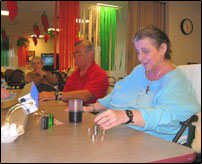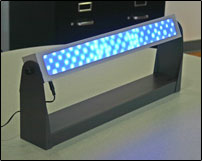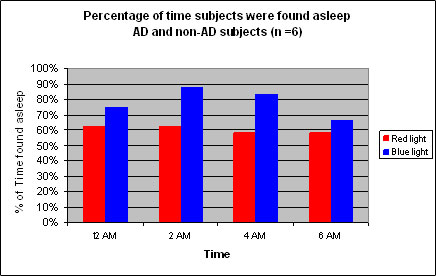|

Effects of Blue Light on the Sleep Quality of Older Adults

Seniors receive the experimental light treatment while playing cards in the residence dining room.

The "blue-light treatment" fixture built for the pilot study. |
Researchers have long believed that the sleep disturbances common among the elderly often result from a disruption of the body’s circadian rhythms—biological cycles that repeat approximately every 24 hours, including the sleep/wake cycle. Those with Alzheimer's disease are particularly susceptible to sleep problems and frequent waking at night.
In recent years, scientists have learned that blue light is the most effective and efficient at stimulating the circadian system when combined with the appropriate light intensity, spatial distribution, timing, and duration.
Through a pilot field study, the LRC set out to demonstrate that exposure to blue light, followed by darkness at bedtime, would create a light/dark pattern that the circadian system would recognize and react to, allowing the elderly to sleep better at night.
EXPERIMENT
The LRC studied the effects of "blue-light treatment" on seniors with and without Alzheimer's disease (AD) at a skilled nursing facility in upstate New York. In the four-week study, the residents were exposed to tabletop LED luminaires for two hours every day from 4:30 p.m. to 6:30 p.m.
For the first two weeks, one group composed of both AD and non-AD residents was exposed to blue LEDs, while another group of both AD and non-AD residents was exposed to red LEDs, a condition introduced as a placebo control. While the circadian system responds best to blue light, it is essentially non-responsive to long-wavelength radiation (red light).
After a short break, the second two-week phase of the experiment began. The residents exposed to blue light in the first phase were exposed to red light in the second phase, and vice versa.
RESULTS
Over the course of the experimental light treatment, the research team analyzed the percentage of time that the subjects slept between midnight and 6 a.m. The study showed statistically significant increases in sleep after blue-light treatment during this period for all subjects.
On average, the non-AD subjects were found asleep 90 percent of the time between midnight and 6:00 a.m. after blue-light exposure and only 67 percent of the time after red-light (placebo) exposure. The AD subjects exposed to the blue-light treatment were found asleep 67 percent of the time compared to AD subjects exposed to the placebo treatment, who were found asleep only 54 percent of the time.
The non-AD subjects’ stronger response to the blue-light treatment was expected, as AD patients have more fragmented sleep patterns than healthy older adults.

TECHNICAL PAPER
Figueiro, M.G., and M.S. Rea. 2005. New research in the light and health field is expanding the possibilities for LED lighting in healthcare environments. CIE Midterm Meeting Conference Proceedings, Leon, Spain.
SPONSORS
Project Sponsor: ASSIST
Site Sponsor: Schuyler Ridge Residential Health Care – Seton Health
Equipment Sponsor: NICHIA America Corp.
RELATED NEWS AND INFORMATION
LRC Light and Health Web site
http://www.lrc.rpi.edu/programs/lightHealth/
Researchers use blue light to treat sleep disturbances in the elderly – LRC Newsletter
http://www.lrc.rpi.edu/resources/news/enews/Apr05/general245.html
Bright side of blue light - LD+A
http://www.lrc.rpi.edu/programs/lightHealth/pdf/blueLight.pdf
|


